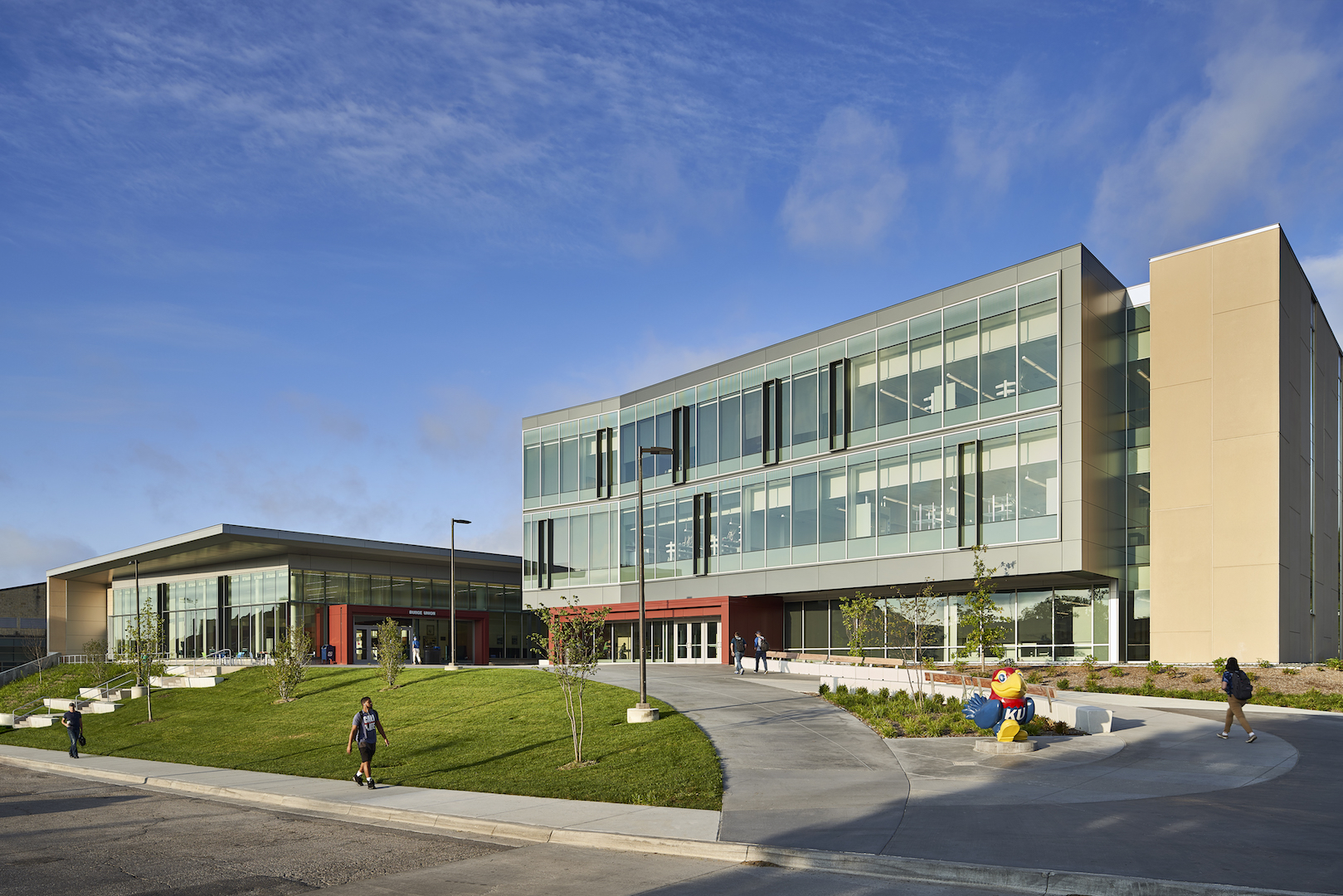Public-Private Partnerships in higher education spurred by uncertainties in government funding

Public-Private Partnerships in higher education spurred by uncertainties in government funding, by Daniel Lacy, Vice President, Business Unit Leader, McCownGordon Construction
Government cutbacks on infrastructure spending in recent years have contributed to greater demand for public-private partnerships, known as P3 or PPP. These arrangements enable private funding of public infrastructure with the transfer of risk to the private sector. Public-private partnerships promote higher quality, enhanced creativity and greater coordination by bringing all parties and experts to the table. Greater efficiencies enabled by P3s can move projects to completion faster and reduce inflationary costs. Public-private partnerships have been found to work particularly well in the higher education sphere. They are highly customizable but are not suited for all projects. The decision to go P3 should be considered on a case-by-case basis considering the unique circumstances of each project.
U.S. Infrastructure: Growing needs, declining resources, innovative solutions
The United States, once the world’s infrastructure powerhouse, has been falling behind. In its recent report, entitled “It’s Time for States to Invest in Infrastructure,” the Center on Budget and Policy Priorities found that states are cutting infrastructure spending as a share of the economy…the opposite of what is needed” according to the report’s authors.
According to the report, “federal infrastructure investment has fallen by half ― from 1 percent to 0.5 percent of GDP ― over the last 35 years, leaving more of the task to state and local governments.” Further, according to the report, “states must turn their attention back to the type of infrastructure investments that will boost productivity, support business growth, create jobs, provide a healthier environment and improve opportunities for all of their residents.”
Similarly, a report by the Brookings Institution entitled “Private Capital, Public Good,” states that “infrastructure in the United States has not received an adequate level of investment for years.” The report goes on to state that the problem is “forcing leaders across the country to explore new ways to finance the investments and operations that will grow their economies over the next decade.”
This exploration has led to new kinds of agreements between governments at all levels and the private sector to deliver, finance and maintain a range of projects. Beyond simplistic notions of privatization, the interest is in true partnerships between agencies, private firms, financiers and the general public.
Public-private partnerships: What are they and how do they work?
Simply stated, a public-private partnership is a cooperative venture between a public, tax-supported entity and a private business. A public-private partnership is not a project delivery method. It is a funding mechanism that can be leveraged to fund virtually all projects no matter what the delivery method: design-build, traditional design-bid-build or other.
The growing interest in P3s stems from tighter budgets, greater project complexity, seeking better value for money, the desire to leverage private sector expertise and shifting public sector priorities.
According to a report by the Harvard Kennedy School, “U.S. Infrastructure Public-Private Partnerships: Ready for Takeoff?” the U.S. public-private partnership market has developed dramatically since the “catalyzing” $1.8 billion Chicago Skyway lease was completed in 2005.
From 2005 to 2014, 48 infrastructure P3 transactions with an aggregate value of $61 billion reached the formal announcement stage. Forty of those projects successfully closed, the Harvard Kennedy report states. “The primary drivers of infrastructure P3s – new sources of capital, cost savings, risk transfer, and accountability – remain strong.”
Interestingly, P3s have been portrayed as either a panacea to all of America’s infrastructure challenges or as a corporate takeover of critical public assets. In reality, P3s are neither.
Higher Education—a hot spot for P3s
P3s are playing a growing role in public infrastructure. While P3s debuted in the transportation sector, they have matured in the buildings market—particularly higher education. “P3s continue to change the context in which higher education defines its financial and political limitations,” said Jose Coll, a Fellow with the American Council on Education. “In recent years we have seen a multitude of collaborative partnerships which range from a 50-year, $438 million lease for parking assets at Ohio State University to a partnership made up of $260 million in cash and savings at Texas A&M, which privatized its dining, landscaping and building maintenance services.”
Many university departments are already working at capacity due to reduced budgets, hiring freezes and capital cutbacks. However, with university enrollments at a historic high, these institutions are seeing the benefits of seeking a private partner as they struggle to expand and redevelop their facilities.
Key to the public-private partnership funding method is an available revenue stream that is used to compensate the private partner in the project. The popularity of public-private partnerships in higher education projects has been largely driven by the revenue generated from student housing. Indeed, P3s have worked so successfully in student housing that they are expanding into other types of campus infrastructure projects. These include parking garages, recreation centers and renewable energy initiatives.
Institutions of higher education primarily are designed for teaching and research. The work of managing major redevelopment is not part of the skillset so bringing in a private company with development expertise makes sense. It greatly reduces the pressure on campus staff to take on a major effort that is outside of their core business. Outside expertise can also result in lower construction costs, expedited timelines and better, more effective buildings that capitalize on the latest academic trends.
Case Studies: Successful education-oriented public-private partnerships
University of Kansas Central District Development. To expand its growing campus, the University of Kansas selected a joint venture that includes Clark Construction and McCownGordon for KU’s Central District Development. KU used a public-private partnership delivery method with Edgemoor Infrastructure & Real Estate as the developer for the design-build project.
The Edgemoor team provided construction services for the 55-acre site that include a 285,000-square-foot science facility; a 26,500-square-foot student union; 1,250 beds of student housing in three buildings; 2,000 surface parking spaces; a central plant facility, a 595-space parking structure and utility and transportation infrastructure.
Edgemoor took responsibility for implementing the initial phase of the master plan, including development, financing, building, operations and maintenance.
The cost of the project was approximately $350 million. Jim Modig, KU’s architect and director of design and construction management, said using the more traditional method (wherein the state manages the project and bids it out piece by piece) would have cost an additional $25 to $100 million and added five or six years to the development timeline.
If KU had employed the more traditional development method, without a public-private partnership, “we couldn’t have undertaken the project to the order of magnitude that we’re talking about today with the staffing that we currently have available,” Modig said. “Our function becomes more review-oriented in managing a single contract vs. multiple contracts.”
Under the P3, KU created an affiliated not-for-profit corporation known as the KU Campus Development Corp. The corporation bonded the project and paid Edgemoor for the development. KU makes lease payments to the not-for-profit corporation, which applies that money to the debt service.
Northland Innovation Campus. This $20 million project is an educational collaboration of the City of Gladstone, Northwest Missouri State University, the North Kansas City School District and CBC Real Estate Group. The project includes a 90,000-square-foot building that provides space for educational programs and private businesses. This Northland Innovation Campus follows significant redevelopment that has occurred in Gladstone, Missouri in recent years.
From the beginning, Gladstone and the North Kansas City School District envisioned a public-private partnership arrangement in which the developer would finance a construction loan and take on the construction risk which would make the project more financially feasible. A request for proposal was issued and Gladstone selected a team that included CBC, McCownGordon and Hoefer Wysocki.
“For public institutions such as a school district or university, a public-private partnership can be very attractive because it doesn’t necessarily require a huge capital outlay,” said Jason Glasrud, CBC’s development manager. “In this case, we’re talking about a $20 million construction loan. They’re able to have a few degrees of separation by bringing on a private developer who finances that and takes on the construction risk. The tenants are locked into a long-term lease rate. They’re protected from changes in construction pricing and things of that nature.”
CBC brought all parties to the table during the development process – the development plan was based on feedback from the city, school district and school district faculty. That feedback led to the incorporation of features such as a circular drive for student drop-off and pick-up.
The emphasis on communication and coordination enabled the development to progress more quickly and save money on inflationary costs.
The Northland Innovation Campus is owned by CBC, and the North Kansas City School District leases about two-thirds of the space. CBC obtained a 20-year property tax abatement through Missouri Chapter 100 bonds which will enable them to charge lower lease rates to tenants.
The U.S. Attorney’s Office for the Eastern District of Oklahoma. The P3 team for this office space included US Federal Properties and Hoefer Wysocki, with McCownGordon serving the General Services Administration, a government agency tasked with managing government buildings and real estate. The intent of the building’s concept is an expression of the Office’s transparent relationship with the public, as well as to serve as first-class, secure office space for the U.S. Attorney and his staff.
GSA has often employed the public-private partnership funding method and was a uniquely well-informed partner in the process. In working with GSA, US Federal Properties utilized the purest form of a design-build contract and provided a full turn-key solution which included design, construction, furniture, fixtures, and equipment.
The P3 funding mechanism was a 20-year lease procurement. US Federal Properties owned the building and the land while the GSA leases the building. At the end of the 20-year lease, the GSA has the option to renew the lease or terminate the lease with no ownership obligations.
One common misconception regarding public-private partnership funding is that it can result in a loss of control by the project owner which can compromise satisfaction in the final product. The resulting building completed for the GSA and US Federal Properties tells the true story. Due to the nature of the work being performed in the building, the GSA had specialized needs for the building including highly specific requirements for a soundproof room needed to ensure secure communication with government agencies. The collaborative nature of the P3 process, bringing all parties to the table, ensured the specialized needs of the client were accommodated and that they received the building they needed and desired.
In addition to the P3 funding methods moving the project forward, the design-build delivery method also contributed to its success. McCownGordon, working closely with Hoefer Wysocki, was able to deliver estimates in concert with design and come to a guaranteed maximum price prior to completed documents. The availability of an early GMP, moved the project forward faster than with the traditional design-bid-build method. As a result, the project was delivered approximately two months earlier than the contract schedule at a cost of $9.8 million. The early completion saved costs for project staffing, loan interest and allowed the owner to begin receiving rent two months earlier than originally expected.
Recommendations for Achieving Successful P3s
Based on McCownGordon’s experience with successful P3 projects, our firm’s number one recommendation is to ensure the project owner has a P3 champion in place. It is the champion’s role to effectively communicate and convince the public of the positive value of the P3 funding method. Projects will struggle if constituents perceive P3 projects as simply privatizing, or worse, as selling public services.
The Brookings Institution report also has some recommendations for public leaders as they consider P3s:
- Create a strong legal framework at the state level. P3s require a sound legal basis to ensure that the public sector has the authority to pursue a deal and allows the private sector to mitigate unnecessary political risk.
- Prioritize projects based on quantifiable public goals. Not every infrastructure project is suitable for a P3, so it is essential for policymakers to base their procurement decisions on economic and financial analysis that captures the social, environmental and fiscal impacts of the deal.
- Pick politically smart projects. A successful P3 requires a pragmatic understanding of what is feasible in a constantly evolving political environment.
- Understand what the private sector needs. Strong partnerships are based on finding the right alignment of interests, which is why it is essential to understand what makes a project appealing to private sector investors.
- Find the right revenue stream. P3s are not free money; they require localities to find durable and resilient revenue sources that will pay for the investment over the long term.
- Create a clear and transparent process. Routinization and standardization will create a market for P3s that provides the public and private sector with a clear road map for success.
- Build an empowered team. Assembling an empowered public sector team that is capable of making and executing informed procurement decisions is an essential part of any successful P3.
- Actively engage with stakeholders. P3s are inherently complex deals that require significant public engagement to ensure that the deal is in the interest of the community and executed at the highest standards possible.
- Monitor and learn from the partnership. P3s involve decades of dedicated attention that requires thoughtful monitoring, flexibility in the face of a changing world and a willingness to learn from mistakes.
Caveats when considering P3
While P3s offer many benefits to higher education institutions, these agreements also may come with disadvantages that must be considered. Depending on how the deal is structured, disadvantages may include:
- A higher cost of capital than bonds or capital fundraising campaigns
- Reduced control for the university as more partners are brought to the table
- The greater complexity of the deal as private partners demand additional terms, etc.
- Multi-party roles and responsibilities among team members to be coordinated and monitored
Choose Carefully to Attain P3 Success
Most of the P3s entered into by universities and private developers have proven to be successful. Educational entities contemplating such an arrangement should remember that each project is unique. As we have seen in the P3 projects we have been involved with, If you’ve done one P3 project, you’ve done one P3 project. Each one needs to be individually crafted and carefully adapted to meet the owner’s needs.
Developers and construction managers that specialize in partnerships with universities can offer a wealth of knowledge in determining the best structure for each situation. When choosing a development partner, universities should look for a firm that not only can deliver high-quality work, but also can support them throughout the process with a broad array of services, access to third-party financing and expertise in managing complex financials.
About the Author
Daniel Lacy, Vice President, Business Unit Leader, leads the higher education market for McCownGordon. His portfolio includes work performed for some of the region’s most notable institutions including Kansas State University and the Kansas State University Foundation, University of Central Missouri and South Dakota State University. He has developed an expertise in higher education construction, as well as large complex projects that require extensive coordination and communication. Daniel excels at understanding client needs and developing unique and innovative solutions to meet those needs.
Learn More
McCownGordon is dedicated to helping customers realize their plans for expansion and continuous improvement in the learning environment on campus. Our expertise and knowledge draw from years of experience solving construction problems.
Interested in learning more? Check our other higher education projects and sign up to receive newsletter.






